Indian singer and Bollywood icon Lata Mangeshkar died Feb. 6 in Mumbai, India. She was 92 and was suffering from multiple post-COVID complications.
She was admitted to Mumbai’s Breach Candy Hospital in January with pneumonia. Indian media have reported that she also had heart problems.
Mangeshkar, dubbed “the queen of melody” by Indian media, sang mostly film songs, though many were also religious tunes called bhajans. She was also responsible for singers earning royalties rather than just a one-time payment thanks to a lone battle she waged in the 1960s that finally bore fruit in 2018.
In a tribute to her, the late Dilip Kumar once said, “The way the fragrance of a flower has no color, a flowing spring or cool breeze belongs to no country, the smile of an innocent child has no religion, similarly Lata Mangeshkar’s voice is a miracle of nature’s creativity.”
When her father, musician and theater actor Deenanath, died at an early age, Mangeshkar, the oldest of four siblings, started to sing under the aegis of family friend Vinayak.
Even though detractors said her voice was too reedy, Mangeshkar broke through first in Marathi films and later in Hindi cinema, which was headquartered in what was then called Bombay. Trained in Hindustani classical music, she also studied the Urdu language as many lyricists in the 1940s wrote in that language. Her classical music background is evident in such songs as “Man Mohana Bade Jhoote” in 1955’s “Seema.”
Music director Ghulam Muhammad took her under his wing when the mono-monickered Vinayak died. Muhammad gave her a chance to sing in 1948’s “Majboor.”
In 1949’s “Mahal,” the lead Madhubala lip-synced to Mangeshkar singing “Aayega aanewala,” which went on to be one of her evergreen hits.
While she fought for a place with other singers such as Noor Jehan and Shamshad Begum, she soon became the undisputed queen of Bollywood.
Also hugely popular were her duets with Talat Mehmood, Rafi, Mukesh and Hemant Kumar. Her albums sold in big numbers for HMV, which released them. She tried to get royalties in the 1960s, but producers thought that a one-time payment sufficed.
“The music company Saregama HMV has nearly all my songs,” she complained in 2012 when lyricist Javed Akhtar tried to get royalties. “They are putting my songs in various compilations of Naushad, Salil Chowdhary, Bappi Lahiri,etc. What do I get from this? I don’t get any royalty. Now there is internet and the MP3 format.” The same year, amendments to the Indian Copyright Act, 1957 came into force, ensuring royalties for singers. In 2013, the Indian Singers’ Rights Association, chaired by Mangeshkar, was formed to campaign for singers’ royalty payments. In 2018, Indian singers finally began receiving royalties.
Across her career, Mangeshkar lent her voice to actors from Nargis to Jaya Bhaduri from the 1950s to the 2000s. In an interview, Bhaduri relayed her thrill when she found out that “Lataji” was willing to lend her voice to a rookie like her.
During a span of 40 years, Mangeshkar and her sister Asha Bhosle ruled the Bollywood music industry. Composers from Anil Biswas and C. Ramchandra to S.D. Burman and his son, R.D. Burman, to Naushad and even A.R. Rahman hired her to sing for them.
Even after composer Madan Mohan died, her voice was fused to his tunes for 2004’s “Veer-Zaara.”
Among Mangeshkar’s many awards and honors were three top ones from the Indian government: Bharat Ratna, Padma Bhushan and Padma Vibhushan.
Mangeshkar never married. She is survived by two sisters, Bhosle and Meena Khadikar, both of whom are singers. Her brother, the composer Hridaynath, preceded her in death.
Source: Read Full Article
